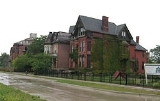
Brush Park, Detroit
Encyclopedia
Brush Park Historic District is a 24 block neighborhood located within Midtown Detroit, Michigan
and designated by the city. It is bounded by Mack Avenue on the north, Woodward Avenue on the west, Beaubien Street on the east, and the Fisher Freeway
on the south. The neighborhood is experiencing restorations of its historic Gilded Age
, French Renaissance Revival, Victorian
style homes and luring new residents.
. Woodward East is particularly known for the high Victorian
style residences constructed for Detroit's wealthiest citizens. A number of grand houses have been restored in recent years paying particular attention on the various architectural details, including Second Empire slate Mansard roof
s, Romanesque
columns and classical dentiled cornices.
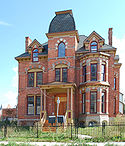 Beginning in the 1850s, entrepreneur Edmund Brush, son of Elijah Brush
Beginning in the 1850s, entrepreneur Edmund Brush, son of Elijah Brush
, the city's second mayor from its first incorporation, began developing his family's property, located conveniently close to downtown, into a neighborhood for Detroit's elite citizens. Homes were built in Brush Park beginning in the 1850s and peaking in the 1870s and 1880s; one of the last homes built
was constructed in 1906 by architect Albert Kahn for his personal use. Kahn lived in this home until his death in 1942, after which it was obtained by the Detroit Urban League, which still uses it today. Other early residents of Brush Park included lumber baron David Whitney Jr., his daughter Grace Whitney Evans, Joseph L. Hudson, founder of the eponymous department store, lumber baron Lucien Moore, banker Frederick Butler, merchant John P. Fiske, Dime Savings Bank founder William Livingstone, and dry goods manufacturer Ransom Gillis. In the late 19th century, the Brush Park neighborhood became known as the "Little Paris of the Midwest."
Architects who designed these mansions included Henry T. Brush
, George D. Mason
, George W. Nettleton, and Albert Kahn. The French Renaissance
style William Livingstone House
(1892–93) on Eliot St. was Albert Kahn's first commission. Livingstone was the founder of the Dime Savings Bank. Originally built about one block to the west of its final resting place to the west of John R, the Red Cross intended to demolish the Livingstone House for their new building. Preservationists succeeded in successfully moving the Livingstone Home about one block to the east. Nevertheless, after this change of position some serious structural problems concerning the house's foundations caused the gradual collapse of the building. Artist Lowell Bioleau commemorated the William Livingstone House in a painting entitled Open House which he unveiled the day of its demolition September 15, 2007, underscoring preservationist efforts.
As of 2001, about 154 original structures remained in the area.
During the 19th century, around 300 homes were built in Brush Park, including 70 Victorian mansions. However, the neighborhood began to decline in the late 19th and early 20th century, when the advent of streetcars and then automobiles allowed prosperous citizens to live farther from downtown. Early residents moved out, notably to up-and-coming neighborhoods such as Indian Village and Boston-Edison
, and the neighborhood became less fashionable. During the Great Depression
, many of the older mansions were subdivided into apartments, and as houses aged in the post-World War II
era, some became unoccupied and fell into disrepair.
Brush Park's revival began in the 1990s and has accelerated recently. A number of the older mansions have been restored, and more have been stabilized. In addition, new condominiums have been built in the southern part of Brush Park, near the Fisher Freeway
. Brush Park Historic District's general boundaries are Woodward Avenue, Mack, Beaubien, and the Fisher Freeway.
district. Residents are zoned to Spain Elementary School for K-8, while they are zoned to Martin Luther King High School
(9-12) for high school.
Michigan
Michigan is a U.S. state located in the Great Lakes Region of the United States of America. The name Michigan is the French form of the Ojibwa word mishigamaa, meaning "large water" or "large lake"....
and designated by the city. It is bounded by Mack Avenue on the north, Woodward Avenue on the west, Beaubien Street on the east, and the Fisher Freeway
Interstate 75 in Michigan
Interstate 75 is a part of the Interstate Highway System and runs from Miami, Florida to Sault Ste. Marie in the Upper Peninsula of Michigan. I-75 enters the state from Ohio in the south, just to the north of Toledo. It runs generally north through Detroit, Pontiac and Bay City, crossing the...
on the south. The neighborhood is experiencing restorations of its historic Gilded Age
Gilded Age
In United States history, the Gilded Age refers to the era of rapid economic and population growth in the United States during the post–Civil War and post-Reconstruction eras of the late 19th century. The term "Gilded Age" was coined by Mark Twain and Charles Dudley Warner in their book The Gilded...
, French Renaissance Revival, Victorian
Victorian architecture
The term Victorian architecture refers collectively to several architectural styles employed predominantly during the middle and late 19th century. The period that it indicates may slightly overlap the actual reign, 20 June 1837 – 22 January 1901, of Queen Victoria. This represents the British and...
style homes and luring new residents.
Woodward East Historic District
The Woodward East Historic District is a smaller historic district, recognized by the National Register of Historic Places, which is completely encompassed by the larger Brush Park neighborhood. The Woodward East Historic District is located on Alfred, Edmund, and Watson Streets from Brush Street to John R Street in Detroit, MichiganMichigan
Michigan is a U.S. state located in the Great Lakes Region of the United States of America. The name Michigan is the French form of the Ojibwa word mishigamaa, meaning "large water" or "large lake"....
. Woodward East is particularly known for the high Victorian
Victorian architecture
The term Victorian architecture refers collectively to several architectural styles employed predominantly during the middle and late 19th century. The period that it indicates may slightly overlap the actual reign, 20 June 1837 – 22 January 1901, of Queen Victoria. This represents the British and...
style residences constructed for Detroit's wealthiest citizens. A number of grand houses have been restored in recent years paying particular attention on the various architectural details, including Second Empire slate Mansard roof
Mansard roof
A mansard or mansard roof is a four-sided gambrel-style hip roof characterized by two slopes on each of its sides with the lower slope at a steeper angle than the upper that is punctured by dormer windows. The roof creates an additional floor of habitable space, such as a garret...
s, Romanesque
Romanesque architecture
Romanesque architecture is an architectural style of Medieval Europe characterised by semi-circular arches. There is no consensus for the beginning date of the Romanesque architecture, with proposals ranging from the 6th to the 10th century. It developed in the 12th century into the Gothic style,...
columns and classical dentiled cornices.
History

Elijah Brush
Elijah Brush was a lawyer and politician from Detroit, Michigan.-Early life:Elijah Brush was born in Bennington, Vermont in approximately 1772, the son of Colonel Nathaniel Brish and Samantha Parker. Brush graduated from Dartmouth College and came to Detroit in 1798.Brush married Adelaide Askin ,...
, the city's second mayor from its first incorporation, began developing his family's property, located conveniently close to downtown, into a neighborhood for Detroit's elite citizens. Homes were built in Brush Park beginning in the 1850s and peaking in the 1870s and 1880s; one of the last homes built
Albert Kahn House
The Albert Kahn House is located at 208 Mack Ave. in Detroit, Michigan. It is currently the headquarters of the Detroit Urban League. The house was designated a Michigan State Historic Site in 1971 and listed on the National Register of Historic Places in 1972....
was constructed in 1906 by architect Albert Kahn for his personal use. Kahn lived in this home until his death in 1942, after which it was obtained by the Detroit Urban League, which still uses it today. Other early residents of Brush Park included lumber baron David Whitney Jr., his daughter Grace Whitney Evans, Joseph L. Hudson, founder of the eponymous department store, lumber baron Lucien Moore, banker Frederick Butler, merchant John P. Fiske, Dime Savings Bank founder William Livingstone, and dry goods manufacturer Ransom Gillis. In the late 19th century, the Brush Park neighborhood became known as the "Little Paris of the Midwest."
Architects who designed these mansions included Henry T. Brush
Henry T. Brush
Henry T. Brush was an American architect who practiced in Detroit, Michigan in the latter part of the 19th century. Brush was born in Detroit, Michigan the son of Amanda Brush. Henry's father was from Canada and died by the time he was 11. Amanda remarried William Cicero Grant who was...
, George D. Mason
George D. Mason
George DeWitt Mason was an American architect who practiced in Detroit, Michigan in the latter part of the 19th and early decades of the 20th centuries.Mason was born in Syracuse, New York , the son of James H. and Zelda E. Mason...
, George W. Nettleton, and Albert Kahn. The French Renaissance
Neo-Renaissance
Renaissance Revival is an all-encompassing designation that covers many 19th century architectural revival styles which were neither Grecian nor Gothic but which instead drew inspiration from a wide range of classicizing Italian modes...
style William Livingstone House
William Livingstone House
The William Livingstone House, constructed in 1893, colloquially named Slumpy was a French Renaissance house located in Detroit's Brush Park. William Livingstone selected Eliot Street in Brush Park and hired architect Albert Kahn who was working for the George Mason-Zachariah Rice firm...
(1892–93) on Eliot St. was Albert Kahn's first commission. Livingstone was the founder of the Dime Savings Bank. Originally built about one block to the west of its final resting place to the west of John R, the Red Cross intended to demolish the Livingstone House for their new building. Preservationists succeeded in successfully moving the Livingstone Home about one block to the east. Nevertheless, after this change of position some serious structural problems concerning the house's foundations caused the gradual collapse of the building. Artist Lowell Bioleau commemorated the William Livingstone House in a painting entitled Open House which he unveiled the day of its demolition September 15, 2007, underscoring preservationist efforts.
As of 2001, about 154 original structures remained in the area.
During the 19th century, around 300 homes were built in Brush Park, including 70 Victorian mansions. However, the neighborhood began to decline in the late 19th and early 20th century, when the advent of streetcars and then automobiles allowed prosperous citizens to live farther from downtown. Early residents moved out, notably to up-and-coming neighborhoods such as Indian Village and Boston-Edison
Boston-Edison Historic District
The Boston-Edison Historic District is a historic neighborhood located in the geographic center of Detroit, Michigan. It consists of over 900 homes built on four east/west streets: West Boston Boulevard, Chicago Boulevard, Longfellow Avenue, and Edison Avenue, stretching from Woodward Avenue on...
, and the neighborhood became less fashionable. During the Great Depression
Great Depression
The Great Depression was a severe worldwide economic depression in the decade preceding World War II. The timing of the Great Depression varied across nations, but in most countries it started in about 1929 and lasted until the late 1930s or early 1940s...
, many of the older mansions were subdivided into apartments, and as houses aged in the post-World War II
World War II
World War II, or the Second World War , was a global conflict lasting from 1939 to 1945, involving most of the world's nations—including all of the great powers—eventually forming two opposing military alliances: the Allies and the Axis...
era, some became unoccupied and fell into disrepair.
Brush Park's revival began in the 1990s and has accelerated recently. A number of the older mansions have been restored, and more have been stabilized. In addition, new condominiums have been built in the southern part of Brush Park, near the Fisher Freeway
Interstate 75 in Michigan
Interstate 75 is a part of the Interstate Highway System and runs from Miami, Florida to Sault Ste. Marie in the Upper Peninsula of Michigan. I-75 enters the state from Ohio in the south, just to the north of Toledo. It runs generally north through Detroit, Pontiac and Bay City, crossing the...
. Brush Park Historic District's general boundaries are Woodward Avenue, Mack, Beaubien, and the Fisher Freeway.
Architecture
| Name | Image | Year | Location | Style | Architect | Notes |
|---|---|---|---|---|---|---|
| Bonstelle Theatre |  |
1902 | 3424 Woodward Ave. | Beaux Arts | Albert Kahn, C. Howard Crane C. Howard Crane Charles Howard Crane was an American architect.Born in Hartford, Connecticut, Crane established a practice in Detroit, Michigan early in the 20th Century. Like Thomas W. Lamb and John Eberson, Crane specialized in the design of movie palaces in North American... |
When Rabbi Leo M. Franklin Leo M. Franklin Leo Morris Franklin was an influential rabbi from Detroit, who headed that city's Temple Beth El from 1899 to 1941.- Early life :... first began leading services of Detroit's Temple Beth El Temple Beth El (Detroit, Michigan) Temple Beth El, also known as Temple Beth-El, is a Reform synagogue currently located in Bloomfield Township, Michigan. Beth El was founded in 1850 in the city of Detroit, and is the oldest Jewish congregation in Michigan.... in 1899, he felt that the construction of a new temple building on Detroit's "Piety Row" stretch of Woodward would increase the visibility and prestige on Detroit's Jewish community. Groundbreaking began on November 25, 1901, with the ceremonial cornerstone laid on April 23, 1902. The structure is listed on the National Register of Historic Places National Register of Historic Places The National Register of Historic Places is the United States government's official list of districts, sites, buildings, structures, and objects deemed worthy of preservation... . |
| Brownstones | 1890 | John R. | Richardsonian Romanesque Richardsonian Romanesque Richardsonian Romanesque is a style of Romanesque Revival architecture named after architect Henry Hobson Richardson, whose masterpiece is Trinity Church, Boston , designated a National Historic Landmark... |
Renovated as condominiums in 2003. | ||
| Frederick Butler House |  |
1882 | 291 Edmund Pl. | French Renaissance Revival Neo-Renaissance Renaissance Revival is an all-encompassing designation that covers many 19th century architectural revival styles which were neither Grecian nor Gothic but which instead drew inspiration from a wide range of classicizing Italian modes... , Second Empire |
Built in 1882, the Frederick Butler House at 291 Edmund Place is a French Renaissance Second Empire style mansion with a Mansard roof Mansard roof A mansard or mansard roof is a four-sided gambrel-style hip roof characterized by two slopes on each of its sides with the lower slope at a steeper angle than the upper that is punctured by dormer windows. The roof creates an additional floor of habitable space, such as a garret... which was restored in 2006 and contains 8400 sq ft (780.4 m²). It is located near Edmund Pl. and Brush St. within the Woodward East Historic District. The original ownwer, Frederick Butler, was a banker. It is presently known as Edmund Place. |
|
| James V. Campbell House | 1877 | 261 Alfred St. | Italianate Italianate architecture The Italianate style of architecture was a distinct 19th-century phase in the history of Classical architecture. In the Italianate style, the models and architectural vocabulary of 16th-century Italian Renaissance architecture, which had served as inspiration for both Palladianism and... |
This house is within the Woodward East Historic District. | ||
| The Carlton | 1923 | 2915 John R. at Edmund | Beaux Arts, Chicago School Chicago school (architecture) Chicago's architecture is famous throughout the world and one style is referred to as the Chicago School. The style is also known as Commercial style. In the history of architecture, the Chicago School was a school of architects active in Chicago at the turn of the 20th century... |
Louis Kamper Louis Kamper Louis Kamper was an American architect, active in and aroundDetroit and Wayne County, Michigan, in the United States.-Project range:... |
Renovated as condominiums. | |
| Carola Building | 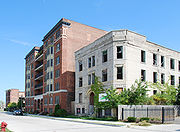 |
1912 | 78 Watson St. | Renaissance Revival | Renovated as condominiums. Pictured to the left of the Devon. | |
| Lyman Cochrane House | 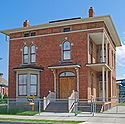 |
1870 | 216 Winder St. | Italianate Italianate architecture The Italianate style of architecture was a distinct 19th-century phase in the history of Classical architecture. In the Italianate style, the models and architectural vocabulary of 16th-century Italian Renaissance architecture, which had served as inspiration for both Palladianism and... |
This house is a relatively rare example of residential Italianate architecture Italianate architecture The Italianate style of architecture was a distinct 19th-century phase in the history of Classical architecture. In the Italianate style, the models and architectural vocabulary of 16th-century Italian Renaissance architecture, which had served as inspiration for both Palladianism and... in Detroit. It was originally built for eye doctor John Terry, but in 1871 was sold to Judge Lyman Cochrane. Cochrane was a state senator and Superior Court Judge, serving in this capacity until his death in 1879. |
|
| Crystal lofts | 1919 | 3100 Woodward at Watson | Art Deco Art Deco Art deco , or deco, is an eclectic artistic and design style that began in Paris in the 1920s and flourished internationally throughout the 1930s, into the World War II era. The style influenced all areas of design, including architecture and interior design, industrial design, fashion and... |
Renovated as condominiums. | ||
| The Devon |  |
1905 | 64 Watson St. | Art Deco Art Deco Art deco , or deco, is an eclectic artistic and design style that began in Paris in the 1920s and flourished internationally throughout the 1930s, into the World War II era. The style influenced all areas of design, including architecture and interior design, industrial design, fashion and... |
Renovated as condominiums in 2011. | |
| John P. Fiske House |  |
1876 | 261 Edmund Pl. | Second Empire, French Renaissance Revival, Victorian Victorian architecture The term Victorian architecture refers collectively to several architectural styles employed predominantly during the middle and late 19th century. The period that it indicates may slightly overlap the actual reign, 20 June 1837 – 22 January 1901, of Queen Victoria. This represents the British and... |
John P. Fiske was a Detroit merchant of china and crockery. The house is within the Woodward East Historic District. | |
| Ransom Gillis House Ransom Gillis House The Ransom Gillis House is an abandoned ruin located at 205 Alfred Street in Detroit, Michigan. It was "mothballed" by the City of Detroit in 2005/2006 in hopes of restoration in the future. The structure has been unoccupied since the mid-1960's.- History :... |
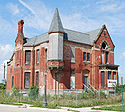 |
1876 | 205 Alfred and John R. | Venetian Gothic Venetian Gothic architecture Venetian Gothic is a term given to an architectural style combining use of the Gothic lancet arch with Byzantine and Moorish architecture influences. The style originated in 14th century Venice with the confluence of Byzantine styles from Constantinople, Arab influences from Moorish Spain and early... |
Henry T. Brush Henry T. Brush Henry T. Brush was an American architect who practiced in Detroit, Michigan in the latter part of the 19th century. Brush was born in Detroit, Michigan the son of Amanda Brush. Henry's father was from Canada and died by the time he was 11. Amanda remarried William Cicero Grant who was... & George D. Mason George D. Mason George DeWitt Mason was an American architect who practiced in Detroit, Michigan in the latter part of the 19th and early decades of the 20th centuries.Mason was born in Syracuse, New York , the son of James H. and Zelda E. Mason... |
This house has been heavily documented by John Kossik and photographed by documentarian Camilo José Vergara Camilo José Vergara Camilo José Vergara is a Chilean-born, New York-based writer, photographer and documentarian. He was born in Santiago, Chile.Vergara has been compared to Jacob Riis for his photographic documentation of American slums and decaying urban environments... . The house is within the Woodward East Historic District. |
| Bernard Ginsburg House Bernard Ginsburg House The Bernard Ginsburg House is a single family private residence located at 236 Adelaide Street in Detroit, Michigan. It was listed on the National Register of Historic Places in 1991.- Significance :... |
 |
1898 | 236 Adelaide St. | Tudor Revival | Albert Kahn | Bernard Ginsburg was an important figure in philanthropy, civic service, and the Jewish community in Detroit during the late 19th and early 20th century. He commissioned architect Albert Kahn to design this house, one of Kahn's earliest works. Kahn went on to become well-known in industrial and commercial architecture; the Ginsburg house and its English Renaissance style exhibited is typical of Kahn's early work. The house is listed on the National Register of Historic Places National Register of Historic Places The National Register of Historic Places is the United States government's official list of districts, sites, buildings, structures, and objects deemed worthy of preservation... . |
| John Harvey House |  |
1887 | 97 Winder St. | Second Empire | John V. Smith | John Harvey was a pharmacist and philanthropist. The house contains 11000 square feet (1,021.9 m²), eight marble fireplaces, and three-story staircase. Devolopers purchased the John Harvey House in 1986, renovated the structure, and, in 2005, opened it as the Inn at 97 Winder, a bed and breakfast Bed and breakfast A bed and breakfast is a small lodging establishment that offers overnight accommodation and breakfast, but usually does not offer other meals. Since the 1980s, the meaning of the term has also extended to include accommodations that are also known as "self-catering" establishments... . The house is listed on the National Register of Historic Places National Register of Historic Places The National Register of Historic Places is the United States government's official list of districts, sites, buildings, structures, and objects deemed worthy of preservation... . |
| Hudson-Evans House Hudson-Evans House The Hudson-Evans House is a private, single-family home located at 79 Alfred Street in Detroit, Michigan. It is also known as the Joseph Lothian Hudson House or the Grace Whitney Evans House, and is currently used as the offices of a law firm... |
 |
1872 | 79 Alfred St. | Second Empire, French Renaissance Revival, Italianate Italianate architecture The Italianate style of architecture was a distinct 19th-century phase in the history of Classical architecture. In the Italianate style, the models and architectural vocabulary of 16th-century Italian Renaissance architecture, which had served as inspiration for both Palladianism and... |
Unknown | Also known as the Joseph Lothian Hudson House or the Grace Whitney Evans House. The house was a gift from David Whitney Jr. to his daughter Grace upon her marriage to John Evans in 1872. It later became the J.L. Hudson family residence. Listed on the National Register of Historic Places National Register of Historic Places The National Register of Historic Places is the United States government's official list of districts, sites, buildings, structures, and objects deemed worthy of preservation... . |
| Albert Kahn House Albert Kahn House The Albert Kahn House is located at 208 Mack Ave. in Detroit, Michigan. It is currently the headquarters of the Detroit Urban League. The house was designated a Michigan State Historic Site in 1971 and listed on the National Register of Historic Places in 1972.... |
 |
1906 | 208 Mack Ave. | English Renaissance | Albert Kahn | In 1906, architect Albert Kahn built a home for his personal use. He lived in the home from 1906 until his death in 1942. The house is listed on the National Register of Historic Places National Register of Historic Places The National Register of Historic Places is the United States government's official list of districts, sites, buildings, structures, and objects deemed worthy of preservation... . |
| George Ladve House | 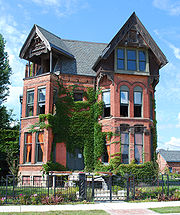 |
1882 | 269 Edmund Pl. | Eastlake Victorian Queen Anne Style architecture The Queen Anne Style in Britain means either the English Baroque architectural style roughly of the reign of Queen Anne , or a revived form that was popular in the last quarter of the 19th century and the early decades of the 20th century... |
Originally owned by George Ladve, 269 Edmund Pl., an Eastlake Victorian style mansion built in 1882 and restored in 2008, contains 7400 sq ft (687.5 m²). Ladve had owned a carpet and upholstery company. In the late 1890s, the Frohlich family added a music room. Frohlich was among the original philanthropists to the Detroit Symphony Orchestra Detroit Symphony Orchestra The Detroit Symphony Orchestra is an American orchestra based in Detroit, Michigan. Its main performance center is Orchestra Hall at the Max M. Fisher Music Center in Detroit's Midtown neighborhood... . The house is within the Woodward East Historic District. |
|
| The Lamar | Watson and John R. | Renaissance Revival | Condominums. | |||
| William Livingstone House William Livingstone House The William Livingstone House, constructed in 1893, colloquially named Slumpy was a French Renaissance house located in Detroit's Brush Park. William Livingstone selected Eliot Street in Brush Park and hired architect Albert Kahn who was working for the George Mason-Zachariah Rice firm... |
1893 | 294 Eliot St. | French Renaissance | Albert Kahn | Constructed in 1893, the Livingstone house was among the oldest historic properties that had fallen into disrepair; it was demolished September 15, 2007.Livingstone hired architect Albert Kahn who was working for the George Mason-Zachariah Rice firm. When he obtained this commission – presumably with Mason’s help - Kahn was only 22 or 23 years old and had just returned from spending 1891 in Europe studying the classical architecture of the Old World. Kahn's decision to design in a French Renaissance mode for the home reflected the time he spent sketching the best Gallic architecture. | |
| Lucien Moore House | 1885 | 104 Edmund Pl. | French Renaissance Revival, Gothic Revival Gothic Revival architecture The Gothic Revival is an architectural movement that began in the 1740s in England... |
Originally owned by lumber baron Lucien Moore, 104 Edmund Place, designed in a French Renaissance Gothic Revival Gothic Revival architecture The Gothic Revival is an architectural movement that began in the 1740s in England... style and restored in 2006, has 7000 sq ft (650.3 m²). The Lucien Moore House restoration was featured December 27, 2005 by HGTV's restore America Initiative in partnership with the National Trust for Historic Preservation. Presently known as the Moorie Town House. |
||
| H.P. Pulling House | 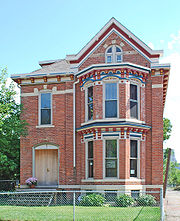 |
48 Edmund Pl. | Victorian Victorian architecture The term Victorian architecture refers collectively to several architectural styles employed predominantly during the middle and late 19th century. The period that it indicates may slightly overlap the actual reign, 20 June 1837 – 22 January 1901, of Queen Victoria. This represents the British and... |
|||
| Emanuel Schloss House | 1870 | 234 Winder St. | Second Empire | Emanuel Schloss was a dry goods merchant and haberdasher in Detroit. In 1870, he built one of the best examples of a Second Empire home that still exists in Detroit. The home has been restored and now operates as the 234 Winder Street Inn. | ||
| Elisha Taylor House Elisha Taylor House The Elisha Taylor House is a private home located at 59 Alfred Street in Detroit, Michigan. The house was designated a Michigan State Historic Site in 1973 and listed on the National Register of Historic Places in 1975. Since 1981, it has served as a center for art and architectural study, known as... |
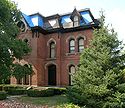 |
1870 | 59 Alfred St. | French Renaissance Revival, Second Empire, Victorian Victorian architecture The term Victorian architecture refers collectively to several architectural styles employed predominantly during the middle and late 19th century. The period that it indicates may slightly overlap the actual reign, 20 June 1837 – 22 January 1901, of Queen Victoria. This represents the British and... , Gothic Revival Gothic Revival architecture The Gothic Revival is an architectural movement that began in the 1740s in England... |
Unknown | The Elisha Taylor House, with its French Renaissance Revival, Second Empire mansard roof Mansard roof A mansard or mansard roof is a four-sided gambrel-style hip roof characterized by two slopes on each of its sides with the lower slope at a steeper angle than the upper that is punctured by dormer windows. The roof creates an additional floor of habitable space, such as a garret... , has distinct elements of Victorian and Gothic Revival style and was built for William H. Craig, a Detroit land speculator. In 1875, Craig sold the house to attorney Elisha Taylor. Taylor was a Detroit attorney who held many offices during his career, including City Attorney, assistant Michigan Attorney General from 1837 to 1841, and Circuit Court Commissioner from 1846 to 1854. The house is listed on the National Register of Historic Places National Register of Historic Places The National Register of Historic Places is the United States government's official list of districts, sites, buildings, structures, and objects deemed worthy of preservation... . |
| Joseph F. Weber House | 1901 | 206 Eliot St. | Georgian Georgian architecture Georgian architecture is the name given in most English-speaking countries to the set of architectural styles current between 1720 and 1840. It is eponymous for the first four British monarchs of the House of Hanover—George I of Great Britain, George II of Great Britain, George III of the United... |
Originally owned by lumber baron Joseph F. Weber, 206 Eliot is a Georgian style house. | ||
| Woodward Place | 2001 | Brush Park | Contemporary Colonial | Contemporary Colonial loft style condominium development. | ||
| First Presbyterian Church First Presbyterian Church (Detroit, Michigan) The Ecumenical Theological Seminary is located at 2930 Woodward Avenue in Detroit, Michigan. It was built in 1889 as the First Presbyterian Church, and listed on the National Register of Historic Places and designated a Michigan State Historic Site in 1979.- Architecture :George D... |
 |
1889 | 2930 Woodward Ave. | Richardsonian Romanesque Richardsonian Romanesque Richardsonian Romanesque is a style of Romanesque Revival architecture named after architect Henry Hobson Richardson, whose masterpiece is Trinity Church, Boston , designated a National Historic Landmark... |
George D. Mason George D. Mason George DeWitt Mason was an American architect who practiced in Detroit, Michigan in the latter part of the 19th and early decades of the 20th centuries.Mason was born in Syracuse, New York , the son of James H. and Zelda E. Mason... |
George D. Mason George D. Mason George DeWitt Mason was an American architect who practiced in Detroit, Michigan in the latter part of the 19th and early decades of the 20th centuries.Mason was born in Syracuse, New York , the son of James H. and Zelda E. Mason... modeled the First Presbyterian Church after Henry Hobson Richardson Henry Hobson Richardson Henry Hobson Richardson was a prominent American architect who designed buildings in Albany, Boston, Buffalo, Chicago, Pittsburgh, and other cities. The style he popularized is named for him: Richardsonian Romanesque... 's Trinity Church Trinity Church, Boston Trinity Church in the City of Boston, located in the Back Bay of Boston, Massachusetts, is a parish of the Episcopal Diocese of Massachusetts. The congregation, currently standing at approximately 3,000 households, was founded in 1733. The current rector is The Reverend Anne Bonnyman... in Boston Boston Boston is the capital of and largest city in Massachusetts, and is one of the oldest cities in the United States. The largest city in New England, Boston is regarded as the unofficial "Capital of New England" for its economic and cultural impact on the entire New England region. The city proper had... . When Woodward was widened in 1936, the elaborately-carved entrance porch was moved from the Woodward facade to the Edmund Place side. The church is listed on the National Register of Historic Places National Register of Historic Places The National Register of Historic Places is the United States government's official list of districts, sites, buildings, structures, and objects deemed worthy of preservation... . |
| First Unitarian Church of Detroit First Unitarian Church of Detroit The First Unitarian Church of Detroit is located at 2870 Woodward Avenue in Detroit, Michigan. It was listed on the National Register of Historic Places in 1982.- History :... |
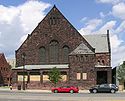 |
1890 | 2870 Woodward Ave. at Edmund | Richardsonian Romanesque Richardsonian Romanesque Richardsonian Romanesque is a style of Romanesque Revival architecture named after architect Henry Hobson Richardson, whose masterpiece is Trinity Church, Boston , designated a National Historic Landmark... |
Donaldson and Meier Donaldson and Meier Donaldson and Meier was an architectural firm based in Detroit, Michigan. Founded in 1880 by John Donaldson and Henry J. Meier the firm produced a large and varied number of commissions in Detroit and southeastern Michigan... |
This church was dedicated in November, 1890. The congregation used the church until 1936, when the widening of Woodward Avenue required a remodelling of the church. The church is listed on the National Register of Historic Places National Register of Historic Places The National Register of Historic Places is the United States government's official list of districts, sites, buildings, structures, and objects deemed worthy of preservation... . |
| Brush Park | 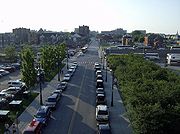 |
1870 | Gilded Age Gilded Age In United States history, the Gilded Age refers to the era of rapid economic and population growth in the United States during the post–Civil War and post-Reconstruction eras of the late 19th century. The term "Gilded Age" was coined by Mark Twain and Charles Dudley Warner in their book The Gilded... |
Various | Brush Park north to Mack Ave., between Woodward and Beaubien. | |
Education
Brush Park is within the Detroit Public SchoolsDetroit Public Schools
Detroit Public Schools is a school district that covers all of the city of Detroit, Michigan, United States. The student population of the Detroit Public Schools is about 65,971 , which is down about 9.7% from the previous school year. Detroit Public Charter Schools educate an additional 56,000...
district. Residents are zoned to Spain Elementary School for K-8, while they are zoned to Martin Luther King High School
Martin Luther King High School (Michigan)
Dr. Martin Luther King, Jr. High School is located at 3200 East Lafayette Boulevard in Detroit, Michigan; the building is operated by the Detroit Board of Education. King's district encompasses Downtown and Midtown Detroit; it also includes the Brewster-Douglass Housing Projects, the Martin Luther...
(9-12) for high school.

